Kharkiv has been at the heart of the conflict between Russia and Ukraine since March. As Russian troops get pushed back east, The Ferret reports on what’s left behind.
Everyone has an image in their head of those vast, monolithic Soviet housing estates. The spalny rayon, or sleeping district. Block after concrete panel block, as far as the eye can see.
Saltivka is one of the biggest such districts. Sprawling over Kharkiv’s northern edge, it is home to more than half a million people. Imagine the scale of this, and now imagine standing in the middle of it, and seeing that every single block of flats around you is either burned, or bombed, or both.
The blackened shells of 16-storey towers loom on either side. We walk through a nice new children’s playground, feeling the glass splinter and crunch under our feet. Smoke is still pouring from the windows of the block ahead of us. The intermittent thud of artillery is not that far away.

It is horribly exposed here. Not only is Russia itself just 20 miles north, but the Russian army was until recently camped out on the outskirts, throwing everything at these northern districts. There are no people, no cars except the twisted wrecks outside every apartment block. Very few birds even, despite the greenery and the pleasant spring weather. A dead pigeon lies on a path.
Soviet-era names carry a deep irony now. In Saltivka we pick our way through tree trunks and rubble, down ‘Friendship of the Peoples’ Street, a Stalinist euphemism popularised in the 1930s, still carrying significance for the older generation who largely believed in the ‘brotherly’ relationship between Russia and Ukraine. These two phrases I’ve now heard countless times in the last three months. Ukrainians spit them out, bitter and contemptuous – so much for that brotherly nation – as they gesture at their ruined homes.

We do find people, eventually – an old couple resting on kitchen chairs outside their block, which is spattered with shrapnel, windows smashed. At the entrance to their basement, where they sleep, a small icon is fixed with a length of wire.
There is no water or gas. They are cooking on a fire with bits of wood, here in the open air. The old woman shows me her cooking pot. It has a round hole, the size of a 50p coin, seared through the side. Shrapnel. She is, somehow, laughing bitterly at this. She calls me my sunshine and just shrugs when I ask why they haven’t left Saltivka. A black cat she’s picked up nuzzles her face adoringly. “I feed ten of them,” she says, as if that settles it.
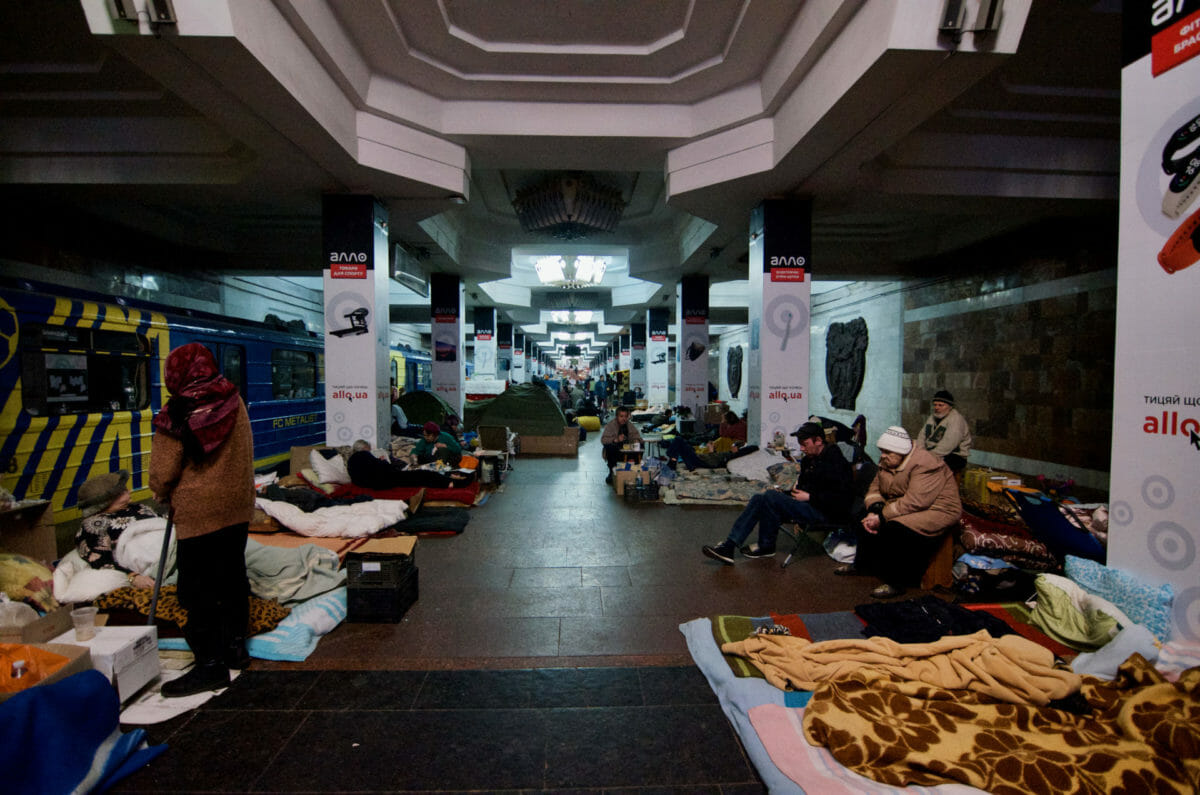
Kharkiv, a city built on trade, was famous for its markets, and Russia has now bombed many of them. Saltivka’s is no exception – just a long row of twisted metal frames. The road here is pitted with small craters. “Cluster bomb”, my colleague says, pointing.
South of Saltivka, on the big arterial road, is a metro station, ‘Heroes of Labour’. This area has also been attacked from the air since day one, and underground, the station’s platform is lined with people. Galina, in her late fifties, shows me her spot near the staircase. Here she sits on a pile of blankets and teaches French online; this is her life now. Her ‘neighbour’ Anna, 70 years old, is sporting a tartan waistcoat. Her eyes sparkle when I say I’m from Scotland. “Just for you!” she chirps, doing a little twirl.
In the underpass that runs under the huge boulevard intersection, loaves of bread and plastic tubs of soup have been placed on a trestle table. People stand around in the semi-darkness, smoking, silent and tense, waiting for the explosions overhead to stop. It’s been nearly three months of this and the exhaustion is etched on their faces.
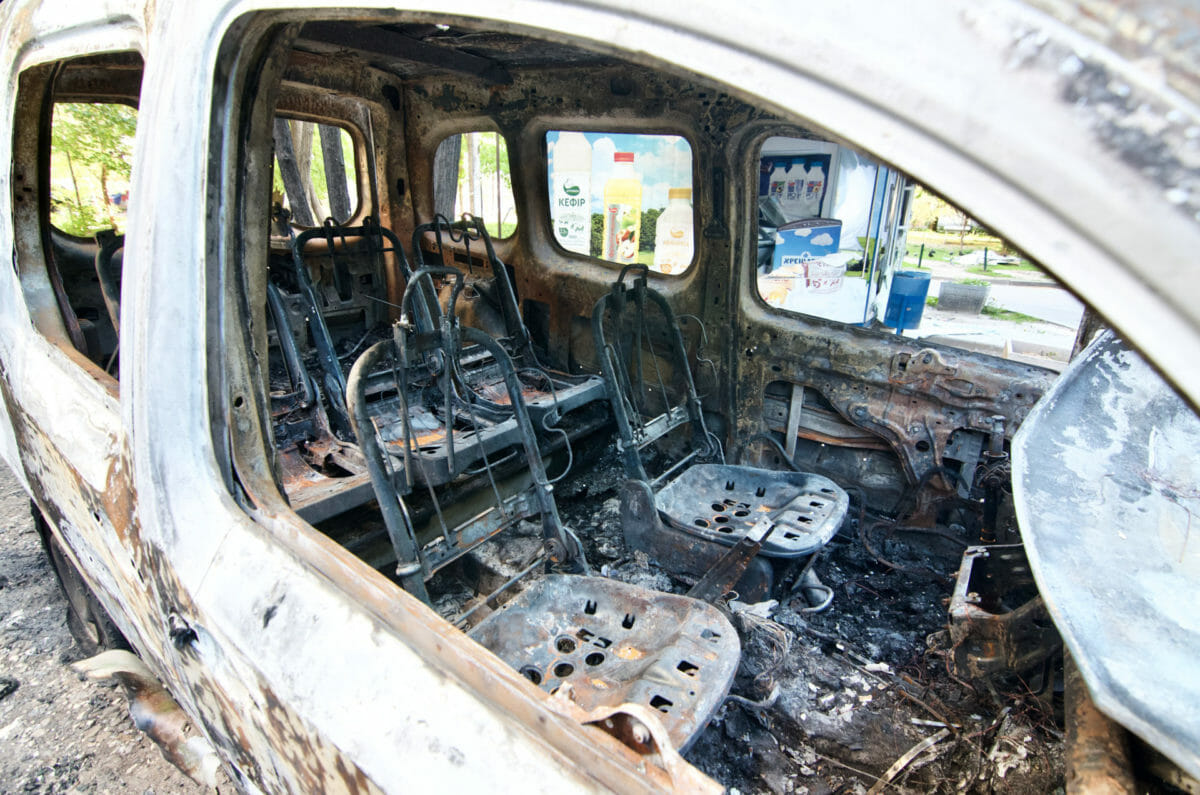
A giant crater
A university, an appeals court, a fire station, and a nursery school were also on Russia’s list. Perhaps their aim really is that bad, as people here joke. Or perhaps of course the deliberate targeting of civilian infrastructure and residential buildings is a tactic of terror, just as it was in Syria, in Grozny. The same planes, the same orders.
The nursery school is no.354 on Derivianka Street. It’s sweet – an ordinary building, but the bricks are painted in bright summer colours around the entrance, now with black scorch marks either side of the door. In the courtyard, a green wooden door hangs off its hinges, revealing a wall painted with a cat and sunflowers.
In front of the flats nearby, the big old trees have been severed, pale splintered wood where the rocket cut them in half. People’s belongings spill out of what used to be balconies. Next stop is a school, then yet another block of flats, a giant crater just underneath the structure, making it look as though the whole thing might suddenly subside.
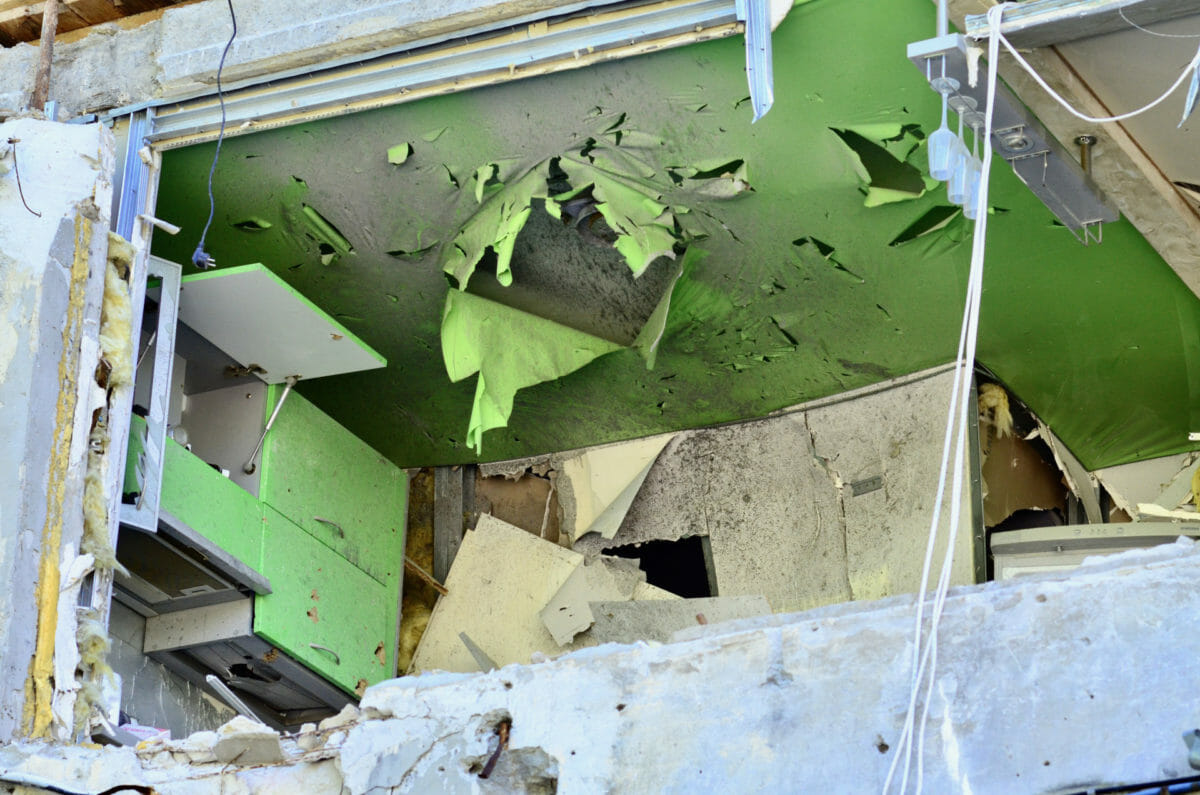
I peer up at the half-intact bedrooms and bathrooms, these little modest flats, their wooden floorboards and lino sticking out over the precipice where the exterior walls have blown clean off. In a lime-green kitchen the walls have practically caved in but a little row of delicate, tall wine glasses are hanging, dusty and perfect, from a ceiling rack. A metal lamppost is shorn in half, studded with rusting holes.
Heroes of Kharkiv
Kharkiv’s incomparably lovely centre, a wildly eclectic mix of architectural styles, was also bombed from the very first day of the invasion. It is somehow more shocking even than Saltivka, to see these famous landmarks, these grand old streets that have withstood so much, reduced in places to ruins.
The worst of it was early March. On the first day of that month the world watched a video clip in which a missile slammed into the huge, neo-classical facade of the regional administration building. It withstood the attack, and the big Stalinist-era building is somehow even more imposing now, black dark holes where the windows were, scorched soot marks up its five-storey stone columns.
The evergreen trees outside are blackened and dead, but in front of the grand entrance city workers have planted yellow and blue pansies.
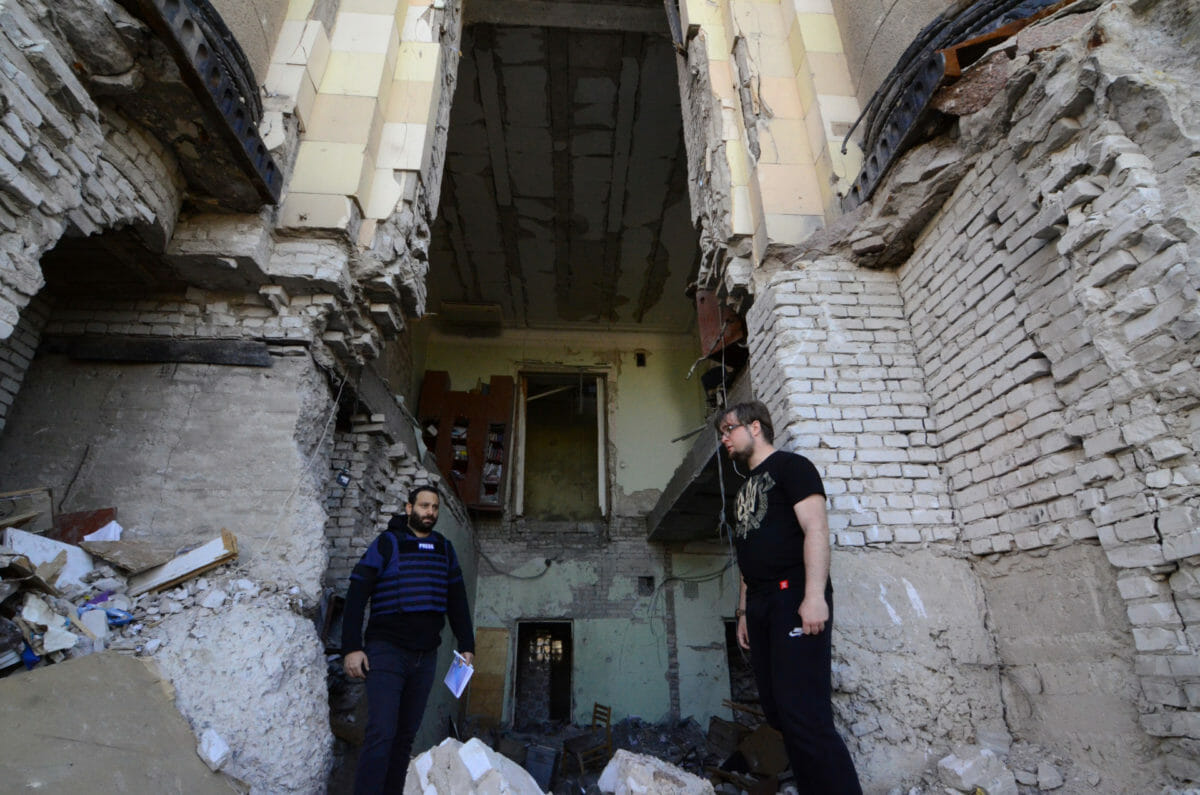
This neat spring planting is everywhere. There may be Russian troops 20 miles away, there may be bombs landing still on Kharkiv, but in the squares and parks the borders are a riot of colour.
A sea of tulips makes a pretty foreground for the huge Derzhprom, a building that makes my heart soar, a 1920s constructivist wonder of symmetry and imagination. Some smashed windows but, thank God, still in one piece. And the tulips are a nice touch, but people question whether the city workers are being put in danger – few have flak jackets, and some were injured when an amusement park was hit in early May.
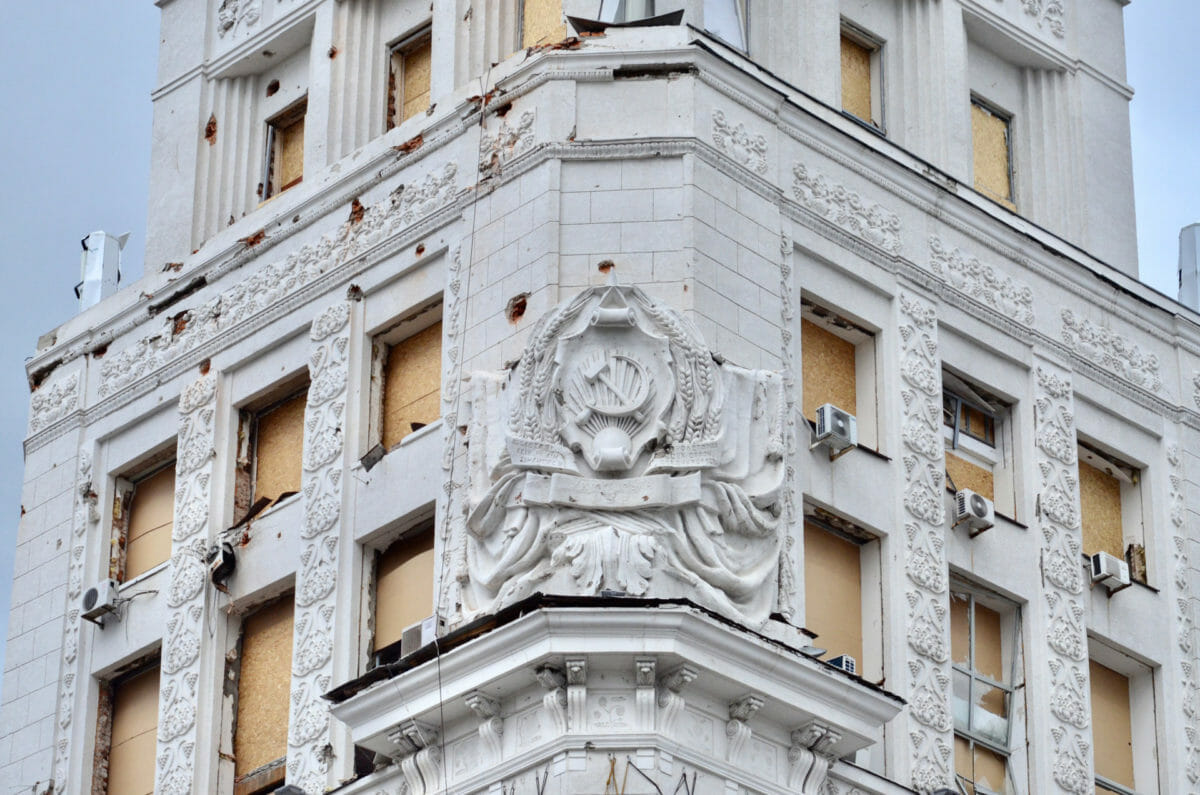
At the top of Moscow Prospekt – just this week renamed ‘Heroes of Kharkiv’ – another Soviet icon sits, its pale facade pitted with shrapnel, not a window left. This grand Stalinist pile houses the city council; behind it are the domes of the pretty Assumption Cathedral. It, too, has visible bomb damage.
In this heart of Kharkiv’s old centre, the beautiful buildings are a mess, but the streets have by now been cleared of debris, and there are even a few cyclists and cars. Once you could stroll down here to the Palace of Labour, through the giant archways of this 19th-century gem into a pleasant courtyard, to enjoy a coffee or buy some vinyl. Hipster paradise.
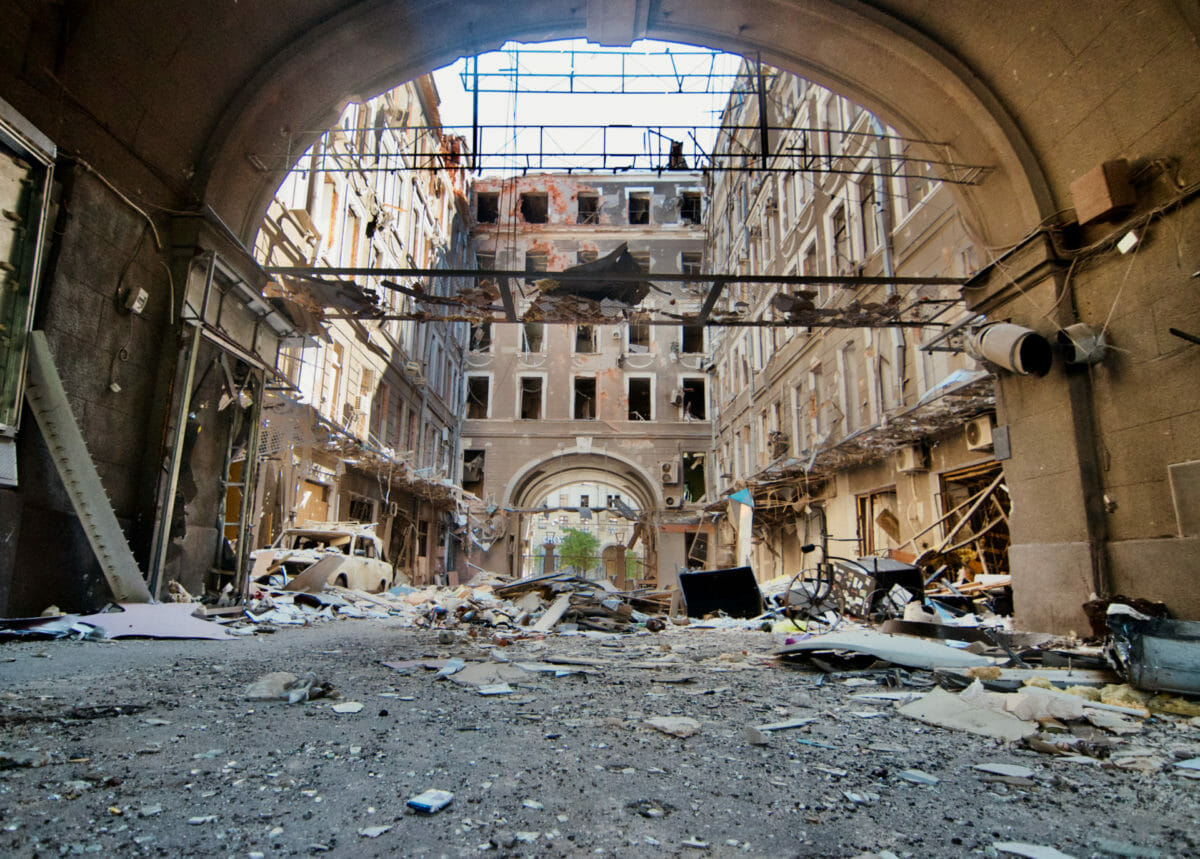
A metal bicycle sculpture, stalwart of trendy street cafes, is still upright, blending in with the other rusted scraps around it. The upper floors have chunks missing, red brick exposed and crumbling. Through a cafe window, more pointless destruction – it doesn’t even look like a kitchen any more, just pieces of kitchen in random order.
This was all achieved with an aerial bomb, dropped by the planes that were roaring over Kharkiv regularly two months ago. I stand looking at the destruction, trying and failing to imagine the terror of that, the deafening noise of that.
Things are quieter in the centre now, but by no means safe. Russian troops might have been pushed back east, away from Kharkiv, but this city’s problem is always going to be its close proximity to the border – at least so long as Russia is a threat.
And as those in Lviv, Odesa, Lutsk, and Ivano-Frankivsk know, being beyond the range of artillery is no guarantee. Missiles can soar in from Crimea, from the Black Sea, from Belarus, lighting up the air-raid siren map in each part of Ukraine until they find their destination. From Kharkiv to Kherson, nowhere is safe.















My heart wrenches as I see these pictures of a beautiful people, the Ukrainians, their lives destroyed by a despot bent to build his ego.
Only God can save Ukraine. And He will. Praying for her early victory.